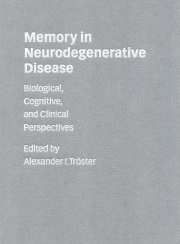Book contents
- Frontmatter
- Contents
- List of contributors
- Preface
- PART I Biological perspectives
- 1 Nonhuman primate models of memory dysfunction in neurodegenerative disease: contributions from comparative neuropsychology
- 2 Nonprimate animal models of motor and cognitive dysfunction associated with Huntington's disease
- 3 Neuropathology and memory dysfunction in neurodegenerative disease
- 4 Neurochemical aspects of memory dysfunction in neurodegenerative disease
- 5 Structural neuroimaging correlates of memory dysfunction in neurodegenerative disease
- 6 Functional neuroimaging correlates of memory dysfunction in neurodegenerative disease
- 7 The biology of neurodegenerative disease
- PART II Cognitive perspectives
- PART III Clinical perspectives
- Index
1 - Nonhuman primate models of memory dysfunction in neurodegenerative disease: contributions from comparative neuropsychology
from PART I - Biological perspectives
Published online by Cambridge University Press: 23 November 2009
- Frontmatter
- Contents
- List of contributors
- Preface
- PART I Biological perspectives
- 1 Nonhuman primate models of memory dysfunction in neurodegenerative disease: contributions from comparative neuropsychology
- 2 Nonprimate animal models of motor and cognitive dysfunction associated with Huntington's disease
- 3 Neuropathology and memory dysfunction in neurodegenerative disease
- 4 Neurochemical aspects of memory dysfunction in neurodegenerative disease
- 5 Structural neuroimaging correlates of memory dysfunction in neurodegenerative disease
- 6 Functional neuroimaging correlates of memory dysfunction in neurodegenerative disease
- 7 The biology of neurodegenerative disease
- PART II Cognitive perspectives
- PART III Clinical perspectives
- Index
Summary
INTRODUCTION
Results of nonhuman animal research can provide new information that human experimentation does not allow, usually for ethical considerations or because of limited control over complex environmental influences. The new knowledge can then be used to help understand human disorders. In the present chapter, we review the application of behavioral methods – developed in nonhuman animal laboratories and modified for human use – toward clarifying memory dysfunction in human neurodegenerative disease. Implicit in nonhuman research models of human brain functioning is the assumption of homologous structural-functional relationships among the species (Riley and Langley 1993; Wasserman 1993). Research on brain mechanisms underlying behaviors across species, contributes to the discovery of common and divergent principles of brain-behavior relationships, ultimately to understand how the brain functions. With understanding comes the potential for assessment and treatment of human neurobehavioral disorders.
One approach to understanding interspecies brain functions, comparative neuropsychology, involves the direct evaluation of human clinical populations by employing experimental paradigms originally developed for nonhuman animals (Weiskrantz 1978; Oscar-Berman 1984, 1994; Roberts and Sahakian 1993). Over many decades of animal research, the paradigms were perfected to study the effects of well-defined brain lesions on specific behaviors and many of the paradigms still are used widely to link specific deficits with localized areas of neuropathology (for reviews, see Medin 1977; Deutsch 1983; Arnold 1984; Stuss and Benson 1986; Meador et al. 1987; Mitchell and Erwin 1987; Fuster 1989; Sahgal 1993). The comparative neuropsychological approach employs simple tasks that can be mastered without relying upon language skills.
- Type
- Chapter
- Information
- Memory in Neurodegenerative DiseaseBiological, Cognitive, and Clinical Perspectives, pp. 3 - 20Publisher: Cambridge University PressPrint publication year: 1998
- 12
- Cited by



